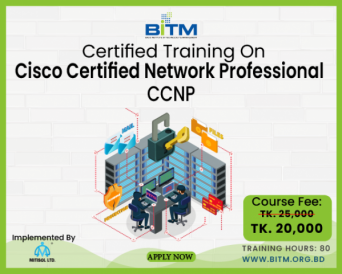This Training is jointly organized by BITM & Mitisol Ltd
Training will be held in Mitisol Ltd
Course Outline:
15% 1.0 Architecture
1.1 Explain the different design principles used in an enterprise network
1.1.a High-level enterprise network design such as 2-tier, 3-tier,
fabric, and cloud
1.1.b High availability techniques such as redundancy, FHRP, and SSO
1.2 Describe wireless network design principles
1.2.a Wireless deployment models
(centralized, distributed, controller-less,
controller-based, cloud, remote branch)
1.2.b Location services in a WLAN design
1.2.c Client density
1.3 Explain the working principles of the Cisco SD-WAN solution
1.3.a SD-WAN control and data planes elements
1.3.b Benefits and limitations of SD-WAN solutions
1.4 Explain the working principles of the Cisco SD-Access solution
1.4.a SD-Access control and data planes elements
1.4.b Traditional campus interoperating with SD-Access
1.5 Interpret wired and wireless QoS configurations
1.5.a QoS components
1.5.b QoS policy
1.6 Describe hardware and software switching mechanisms such as
CEF, CAM, TCAM, FIB, RIB, and adjacency tables
10% 2.0 Virtualization
2.1 Describe device virtualization technologies
2.1.a Hypervisor type 1 and 2
2.1.b Virtual machine
2.1.c Virtual switching
2.2 Configure and verify data path virtualization technologies
2.2.a VRF
2.2.b GRE and IPsec tunneling
2.3 Describe network virtualization concepts
2.3.a LISP
2.3.b VXLAN
30% 3.0 Infrastructure
3.1 Layer 2
3.1.a Troubleshoot static and dynamic 802.1q trunking protocols
3.1.b Troubleshoot static and dynamic EtherChannels
3.1.c Configure and verify common Spanning Tree Protocols
(RSTP, MST) and Spanning Tree enhancements such as
root guard and BPDU guard
3.2 Layer 3
3.2.a Compare routing concepts of EIGRP and OSPF
(advanced distance vector vs. link state, load balancing,path selection,
path operations, metrics, and area types)
3.2.b Configure simple OSPFv2/v3 environments, including multiple
normal areas, summarization, and filtering
(neighbor adjacency, point-to-point, and broadcast network types,
and passive-interface)
3.2.c Configure and verify eBGP between directly connected
neighbors (best path selection algorithm and neighbor
relationships)
3.2.d Describe policy-based routing
3.3 Wireless
3.3.a Describe Layer 1 concepts, such as RF power, RSSI, SNR,
interference, noise, bands, channels, and wireless client
devices capabilities
3.3.b Describe AP modes and antenna types
3.3.c Describe access point discovery and join process
(discovery algorithms, WLC selection process)
3.3.d Describe the main principles and use cases for Layer 2
and Layer 3 roaming
3.3.e Troubleshoot WLAN configuration and wireless client connectivity
issues using GUI only
3.3.f Describe wireless segmentation with groups, profiles, and tags
3.4 IP Services
3.4.a Interpret network time protocol configurations such as NTP and PTP
3.4.b Configure NAT/PAT
3.4.c Configure first hop redundancy protocols, such as HSRP, VRRP
3.4.d Describe multicast protocols, such as RPF check, PIM and IGMP v2/v3
10% 4.0 Network Assurance
4.1 Diagnose network problems using tools such as debugs,
conditional debugs, traceroute, ping, SNMP, and syslog
4.2 Configure and verify Flexible NetFlow
4.3 Configure SPAN/RSPAN/ERSPAN
4.4 Configure and verify IPSLA
4.5 Describe Cisco DNA Center workflows to apply network configuration,
monitoring, and management
4.6 Configure and verify NETCONF and RESTCONF
20% 5.0 Security
5.1 Configure and verify device access control
5.1.a Lines and local user authentication
5.1.b Authentication and authorization using AAA
5.2 Configure and verify infrastructure security features
5.2.a ACLs
5.2.b CoPP
5.3 Describe REST API security
5.4 Configure and verify wireless security features
5.4.a 802.1X
5.4.b WebAuth
5.4.c PSK
5.4.d EAPOL (4-way handshake)
5.5 Describe the components of network security design
5.5.a Threat defense
5.5.b Endpoint security
5.5.c Next-generation firewall
5.5.d TrustSec and MACsec
5.5.e Network access control with 802.1X, MAB, and WebAuth
15% 6.0 Automation
6.1 Interpret basic Python components and scripts
6.2 Construct valid JSON-encoded files
6.3 Describe the high-level principles and benefits of
a data modeling language, such as YANG
6.4 Describe APIs for Cisco DNA Center and vManage
6.5 Interpret REST API response codes and results in
payload using Cisco DNA Center and RESTCONF
6.6 Construct an EEM applet to automate configuration,
troubleshooting, or data collection
6.7 Compare agent vs. agentless orchestration tools,
such as Chef, Puppet, Ansible, and SaltStack
Curriculum
| Training |
Network and Security Training |
80 Hrs |
